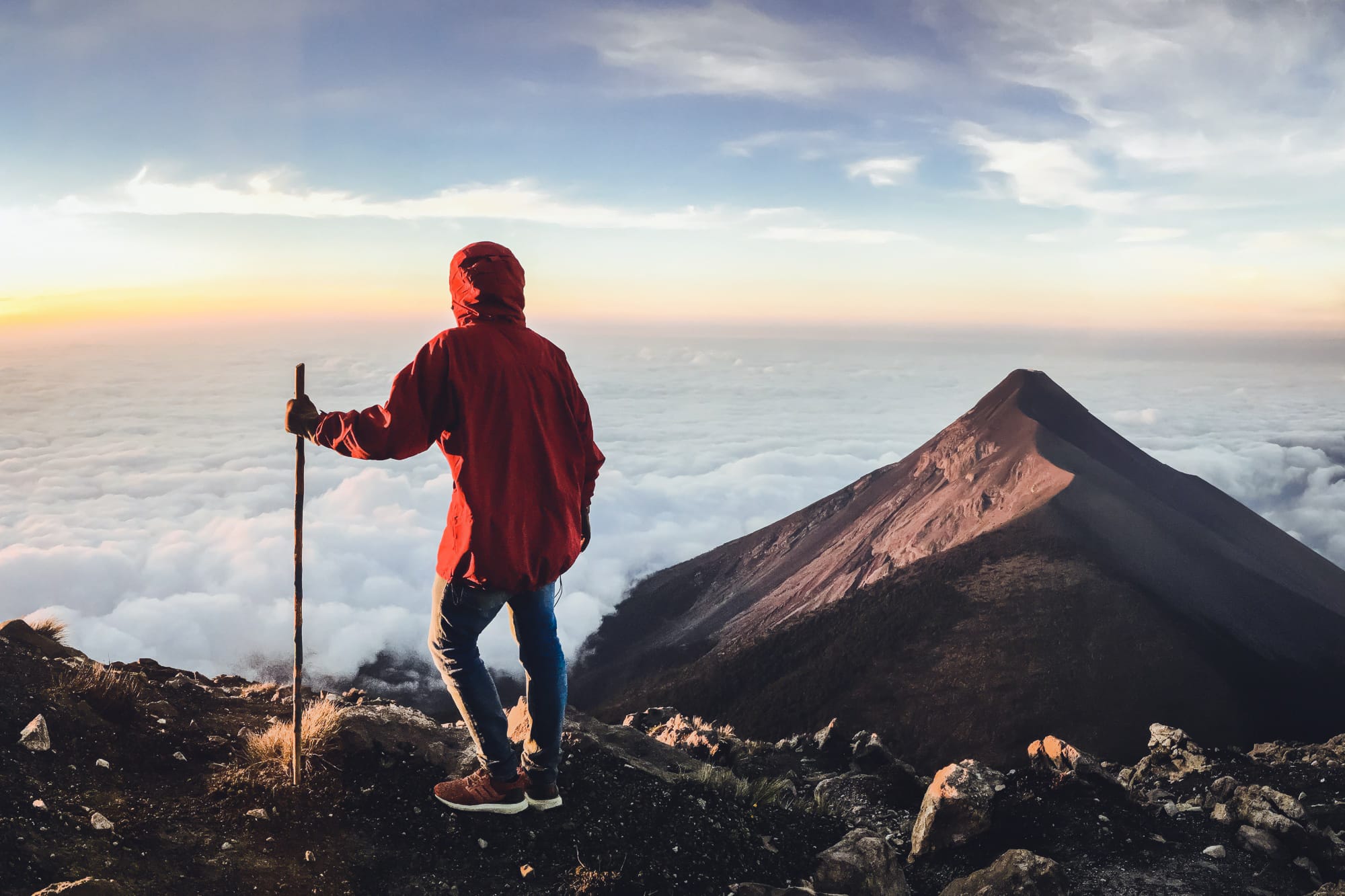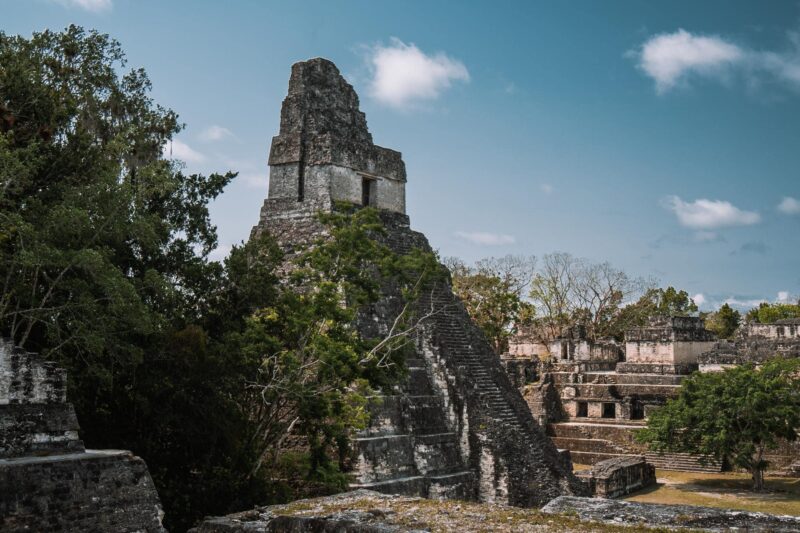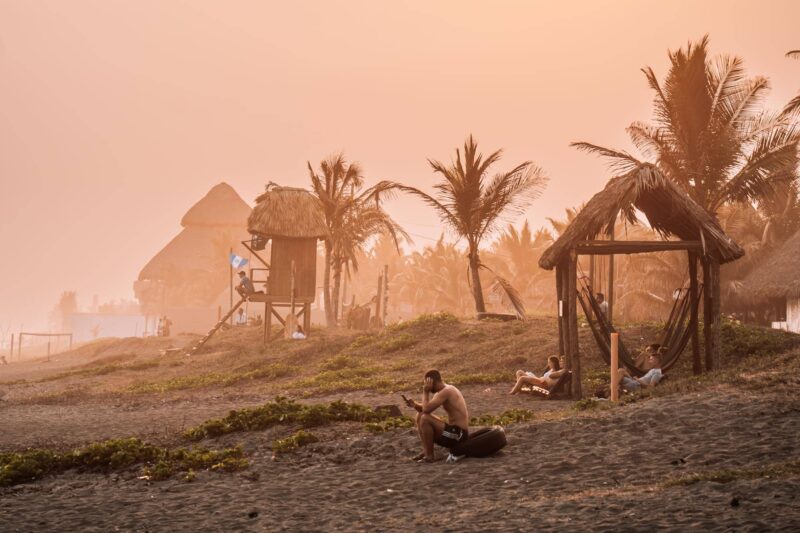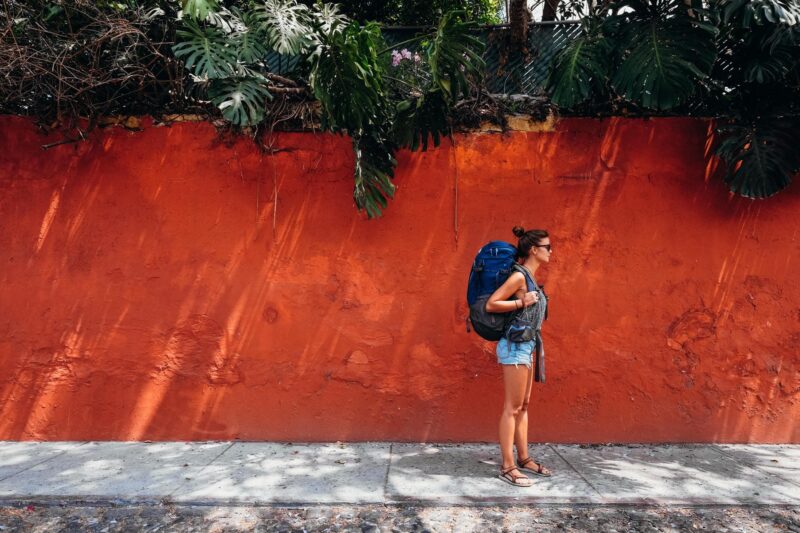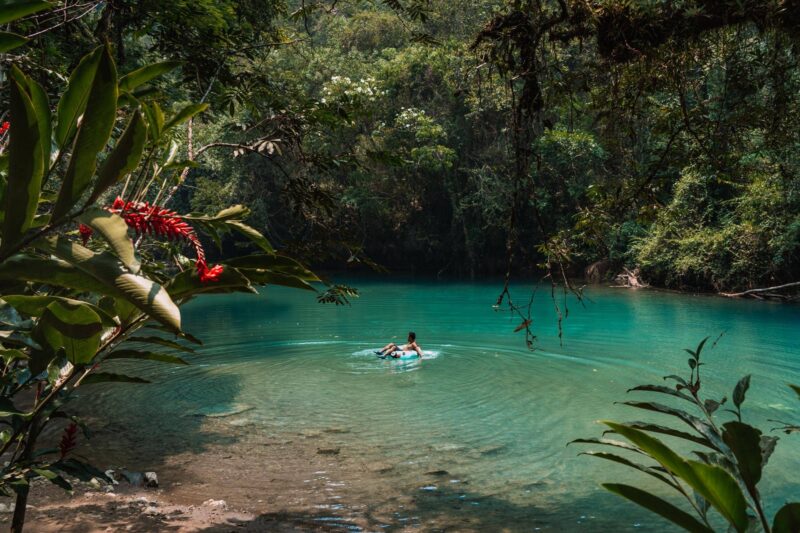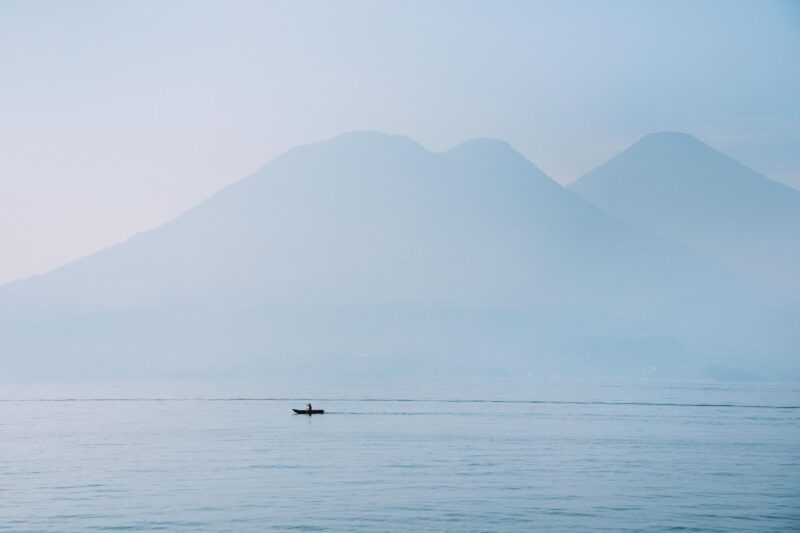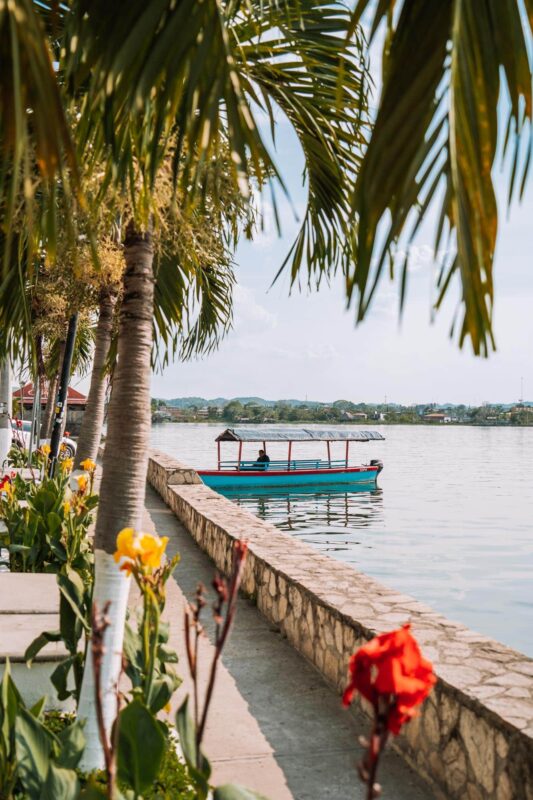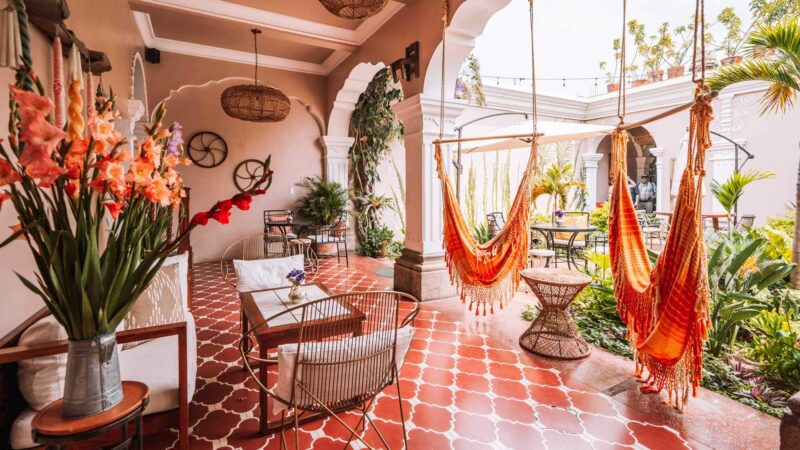Climbing the Acatenango volcano is, for many travelers, both literally and figuratively, the highlight of a trip through Guatemala. During this two-day hike, you can challenge yourself physically and conquer the slopes of this dormant volcano, only to be rewarded with one of the most breathtaking views in Central America. From the base camp, you’ll have front-row seats to a panoramic view of the Fuego volcano. This is the most active volcano in Central America, and with a bit of luck, it erupts multiple times per hour. Smoke, lava, ash, and stones are ejected into the air, creating a spectacle, especially in the dark. Here, you’ll find a detailed description of the tour and practical tips for your adventure to Acatenango.
Important: I climbed the Acatenango volcano with this two-day tour. The photos and experiences in this article are based on that tour. The route is the same with every tour, but there can be significant differences in group size, guides, meals, clothing, and accommodation. You can read more about these differences later in this article.
What Makes the Acatenango Volcano So Special?
Acatenango is a large, dormant giant, standing at 3,976 meters (13,045 feet), making it the third-highest volcano in Guatemala. The hike takes you through three different microclimates to the top, allowing you to walk through entirely different environments every few hours. Once you reach the top, you can enjoy a breathtaking view. From here, you’ll have vistas of the three surrounding volcanoes named Pacaya, Agua, and Fuego.
The Fuego volcano is the most active volcano in Central America, and it can erupt impressively multiple times per hour. Fuego is located right next to Acatenango, earning them the nickname “twin volcanoes.” The two volcanoes are connected, allowing you to hike from Acatenango to Fuego, as you’ll learn later in this article.
Good to know: The activity of Fuego can vary from moment to moment. During my hike, it was very active, with eruptions visible almost every 10 minutes. Most of the year, there are multiple eruptions per day, but sometimes Fuego erupts only once a day. So, while you have a good chance of witnessing spectacular eruptions during this hike, it’s unfortunately not always guaranteed. Additionally, it can be foggy at times, reducing visibility of Fuego.
Is This Two-Day Hike Suitable for Everyone?
Climbing the Acatenango volcano is a challenge but manageable with an average level of fitness. There are some steep sections with loose gravel and sand, which can be more challenging to ascend. Fortunately, there are also less steep paths that are less demanding. It’s worth noting that the higher altitude may cause you to get out of breath more quickly. You may also experience altitude sickness, with symptoms such as headaches and nausea. Guides often have medication for this, and there are plenty of breaks during the hike to catch your breath, making it reasonably doable.
Once you reach the top, it can be quite chilly, and it may even freeze a few degrees. This will have an additional impact on your body, but with enough layers and warm clothing, you can tackle this challenge.
Please note: Climbing Acatenango is not recommended for pregnant women, individuals with heart problems, and others with serious health issues.

What Does the Hike to the Acatenango Volcano Look Like?
To give you a good idea of what the hike looks like, you can read below about the route and the overnight stay. You’ll start at an altitude of approximately 2,800 meters (9,186 feet) and climb to the summit at 3,976 meters (13,045 feet). In total, you’ll walk about 9 hours (5.6 miles) spread over two days.
Day 1: Hiking to the Base Camp
Early in the morning, you depart from Antigua to the village of La Soledad, located at the foot of Acatenango. This is about an hour’s drive. Upon arrival, you can use the restroom, decide whether to rent hiking poles, and whether you want to use a porter. I’ll provide more details on that later.
Then, the hike of about 5 hours (3.1 miles) to the base camp begins. The first hour is also the toughest part of the first day. The dusty path takes you past cornfields and the beginning of the cloud forest. You’ll ascend on loose gravel and sand, occasionally sliding backward. It can be beneficial to walk at the front of the group to avoid the dust kicked up by those ahead. Following this, there’s a short flight of stairs to the entrance of Acatenango National Park, where you pay the entrance fee, so make sure to have some cash with you.
After a short break, you continue the hike through a stunning cloud forest. Everything is green, and the trees are covered in moss and other plants. The trail, zigzagging, takes you to the lunch spot in about 2 hours. Once you’re out of the cloud forest, you can enjoy fantastic views of the expansive surroundings.

The last stretch, about 1.5 hours, is flatter, and the guides call it “the fun part.” You walk past tall pine trees, with only the trunks remaining. Due to a fire, all these trees are dead and bare, but fortunately, some new small trees are beginning to grow in between. It’s a remarkable landscape to walk through.
Once you arrive at your basecamp, the guides and porters will set up any tents for you. In more luxurious tours, the basecamp has cabins. You can put your belongings in your cabin and immediately enjoy the view. In our cabins, there were 6 narrow mattresses with sleeping bags ready. Since you sleep with several people in one cabin, the night is much less cold than in a tent.

With clear weather, you’ll be treated to a fantastic sunset overlooking the volcanoes Agua, Fuego, and Pacaya. Once the sun sets, you’ll enjoy a delicious meal and wait for an eruption from Fuego. The campfire is lit, and a nice drink is served. Afterward, you probably want to get into your bed quickly because there’s usually a strong wind that makes it freezing cold. With a few layers of clothing on, you crawl into your sleeping bag.
Do you wake up to the rumbling sound of the volcano? Look outside, and you’ll need to pinch yourself to believe you’re awake. In the distance, you’ll see many headlamps shining, and people are cheering with excitement after the eruption. This sight, under a clear starry sky, has something truly magical.
Tip: During my tour, you had the option to hike further to the Fuego volcano. This costs extra money, but if you have some energy left, it’s a fantastic opportunity. It’s quite a challenging hike over loose gravel, but once you’re on Fuego and it erupts, it’s an incredible experience where you can feel the ground trembling beneath you. You’ll watch the sunset on Fuego and walk back in the dark. The hike from the basecamp to Fuego and back takes about 3 to 4 hours in total. You can decide on the spot whether you want to do this; it doesn’t need to be arranged in advance.

Day 2: Hiking to the Top of Acatenango and Descending
Around 4 in the morning, you’ll be awakened to prepare for the climb to the top of Acatenango. Put on your hat, wear gloves, and attach a headlamp to your head because it’s pitch dark and bitterly cold. It’s only about 1 to 1.5 hours to climb to the top, but this is also the most challenging part of the two-day hike. You walk on loose gravel along the edge of the volcano without being able to see the summit. The higher you go, the fewer trees there are, and the less oxygen there is. Step by step, you walk in a row to the top, and when you look behind you, all you see are a string of headlamps and a magnificent starry sky. Once at the top, you can (on clear days) enjoy one of the most beautiful sunrises you’ve ever seen.
Going back (or even running) from the summit to the basecamp is super fast. Thanks to the loose gravel, you can sort of skate or even run if you feel like it. Breakfast is waiting for you at the basecamp, and then it’s about 3 more hours of walking back to the village at the foot of the Acatenango volcano. After this, you’ll be taken back to Antigua, and the adventure is over!

Packing List for the Acatenango Volcano
It’s wise to prepare thoroughly when climbing the Acatenango volcano. Not necessarily physically, but in terms of gear and clothing. In the night, it can freeze, so wearing lots of layers is a must. Additionally, you’ll likely get quite dusty during the hike, so don’t wear your best clothes. Make sure to bring at least the following items.
- Headlamp
- Toilet paper roll
- Blister plasters
- Sunscreen
- A hat or cap
- Toiletries
- Sunglasses
- Camera + extra batteries
- T-shirt + sweater
- Shorts and long pants
- Thermal clothing
- Gloves
- Warm hat
- Hiking boots or good walking shoes
- Two pairs of hiking socks
- Windproof jacket
- Energy bars and snacks
- Hiking poles
- Pain relievers
- Rain gear
- Tips for the guide and porters
- Cash for entrance fees and optional hike to Fuego
- At least 4 liters of water per person
- Water bottle
Renting or Borrowing Warm Clothing: If you are going on a trip for a few weeks, you can probably bring all these items from home. However, if you are on an extended journey and don’t have space in your luggage, you can also rent clothing from your tour organization. With the tour I did, borrowing warm clothing is included in the price.
Climbing Acatenango Volcano with or without a Porter?
Once you’ve packed the items mentioned in your backpack, you’ll realize it’s quite a few kilos to carry up the volcano, especially if you’re on a low-budget tour where a tent and sleeping bag might also be included. Since the hike itself is already quite an effort without these extra kilos, there’s an option to hire a porter. A porter is someone who walks with the group and carries your bag with your belongings for a fee, typically around $25 per day.
Low-Budget or Deluxe Acatenango Tour? Here’s My Recommendation
There are many different organizations offering tours to the top of Acatenango Volcano, and tour prices vary. The cheapest Acatenango tour can be booked for around $40, but for a better experience, I would recommend going for a slightly more luxurious tour. The route is the same for everyone, but the differences lie in group size, accommodation at the base camp, the number of meals included, and whether you can borrow warm clothing for free. The hike is quite challenging, the night is extremely cold, and the weather can change suddenly. For your comfort and safety, the slightly more luxurious tour is simply better.
I climbed Acatenango with this two-day tour and can highly recommend it. The base camp had comfortable wooden cottages where you sleep with six people. You walk in a small group, the food was delicious, and the guide was friendly and professional. One major advantage is that you can borrow clothing and items for free. A day before the hike starts, you gather with the guide and the group, and they explain about the tour and what you need to bring. They have a room filled with clothing that you can borrow on the morning of the hike, including sweaters, jackets, hats, gloves, scarves, and even backpacks. In my opinion, it’s an absolute must for climbing the Acatenango volcano!
The Low-Budget Tour
- Stay in a simple tent
- You have to carry the tent or hire a porter
- Larger groups
- You need to rent warm clothing
- Meals are usually not included
- Lower quality sleeping bag
- Less well-trained guides
The Deluxe Tour
- Stay in a wooden cottage
- You don’t have to carry a tent
- Smaller groups
- You can borrow warm clothing for free
- All meals are included
- High-quality sleeping bag
- Professional guides
Good to know: You can cancel the more luxurious tour up to 24 hours in advance for free. Ideal when your travel plans change.

What is the base for Acatenango volcano?
The beautiful city of Antigua is the base for climbing Acatenango. Antigua is one of the most charming cities in Guatemala, so be sure to spend a few days there. It’s only an hour’s drive from the starting and ending point of the hike. It is recommended to stay in Antigua for 48 hours before the hike so that your body can acclimatize to the altitude.
Our favorite Places to Stay in Antigua
Ojala is one of the nicest places to stay in Antigua. This beautiful colonial building exudes a relaxed atmosphere, and it’s a great place to meet other travelers. It is very cozy and has many nooks, hammocks, and seating areas. There are both double rooms and dormitories. Here, you’ll experience an oasis of calm in the middle of the city. It’s a two-block walk to Parque Central, so the location is perfect. If you’re looking for a more budget-friendly stay, Yellow House is recommended. The atmosphere here is incredibly pleasant, thanks to all the colors, cheerful staff, and numerous plants. In the morning, you’ll receive a delicious breakfast included in the price. If you have a larger budget, Cacao Boutique Hotel is a treat to stay at. This small-scale hotel feels very cozy and personal. You can certainly get some inspiration for your own interior because it’s beautifully decorated!
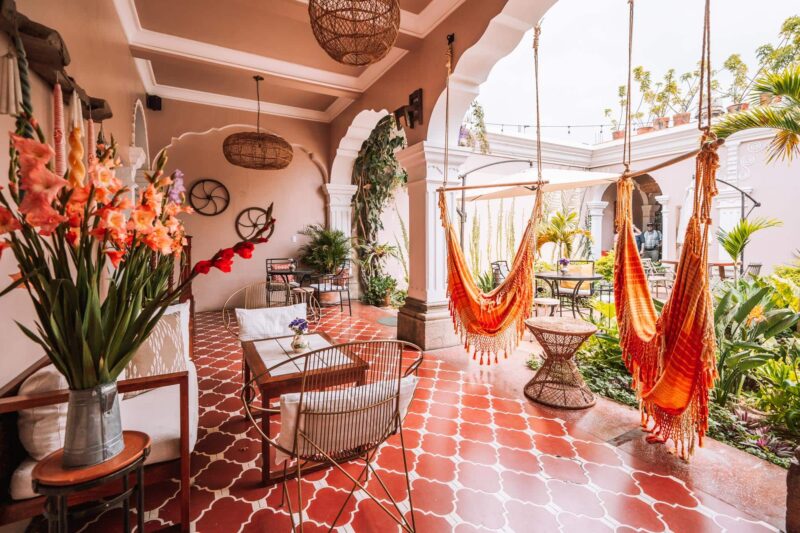 Ojala Ojala |
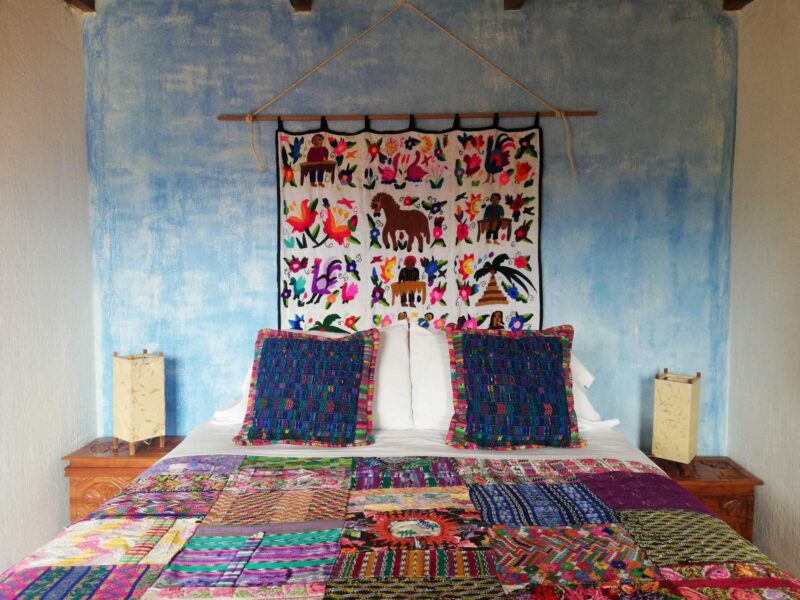 Yellow House Yellow House |
 Cacao Boutique Hotel Cacao Boutique Hotel |
